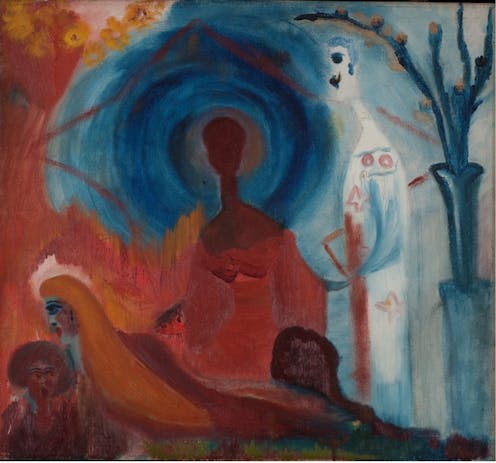Why I love Else Blankenhorn's Allegory with Imperial Couple, and the love story it reveals
- Written by Daniela Mueller, PhD Candidate, The University of Melbourne

In this series, our writers introduce us to a favourite painting.
I often wonder if this mystical painting depicts a “happy ending” for the artist.
Else Blankenhorn (1873–1920) painted Allegory with Imperial Couple during her stay at a mental hospital. The daughter from a wealthy family in Karlsruhe in Southern Germany, Blankenhorn suffered from nervous breakdowns at the age of 26. This led to her first admission for treatment at the private Bellevue Sanatorium in Switzerland in 1899, where she was diagnosed with schizophrenia.
Blankenhorn had received a musical education in her childhood, but it was only in the sanatorium in 1908 that she started to paint and draw.
In only 12 years, Blankenhorn created around 450 artworks. Among them are numerous watercolour and gouache works, expressive drawings, vibrant paintings as well as photographs, embroideries and musical compositions.
Read more: Why weren't there any great women artists? In gratitude to Linda Nochlin
Stories of love
Despite her extensive and versatile oeuvre, Blankenhorn has received limited attention from the art world. She created her artworks in mental hospitals at a time when artworks made by inpatients were generally regarded as clinical case studies, valued for their use in psychiatry and not for their artistic qualities.
Institutionalised female artists were even more at a disadvantage compared with men. Creations by women beyond traditional “female handicrafts” were largely ignored and often thrown away by institutional staff. Some female artists and their works were only recently discovered.
Most of Blankenhorn’s artworks tell a similar story of love, in which the artist plays a significant role. Allegory with Imperial Couple is perhaps one of her most important artworks, and maybe even the point of culmination for the artist herself.
What strikes me first when looking at the Allegory with Imperial Couple is the expressive colours.
Surrounded by bright reds, oranges and blues, the silhouette of a winged female body appears in the centre of the oil painting. With her dress tinted in a strong vermillion, the woman almost seamlessly merges with the jagged shapes in the left middle ground, resembling a fire.
Her face is not defined, yet emphasised by rings in different blues that surround her head, reinforcing the mysterious atmosphere of this artwork.
The woman’s appearance strongly contrasts with the figure on her right. Painted in white and different tones of blue, a man seems to float into the image space. This time, the face is accentuated. Both figures appear to hold hands. Who is this contrasting couple?
I am intrigued by this painting’s enigmatic aura. In her artworks, Blankenhorn painted and drew scenes from her imagined life. By the strong, almost dramatic contrasts in colour and figures, one can sense the importance of this depicted scene for Blankenhorn.
Self-portraits
Blankenhorn believed herself to be married to the German Emperor Wilhelm II. He assigned to his “wife in spirit” the responsibility to resurrect and nourish all the married couples that are buried, but not deceased.
Blankenhorn produced a multitude of original banknotes, with the value of many billion thalers (a unit of currency in Germany until 1908) and sometimes of ever larger sums such as “centuplons”, “quadruplons” and “seidublons of Marks”. These were all invented currencies by Blankenhorn with which she aimed to finance her imagined mission.
Most of these imaginative banknotes feature angelic, hybrid creatures that resemble the artist. The shadowy female figure at the centre of the Imperial Couple shows similarities to other self-representations of Blankenhorn in the woman’s body posture, prolonged neck and shape of the head, as in her self-portrait as a singer.
Given what we know about Blankenhorn’s inner world, we can identify the male figure next to her in the painting as the Emperor, with his characteristic moustache and the white robe adorned with stellar and round ornaments.
While His Majesty remains in a seemingly transcendental space, the “Empress Else of Germany”, as Blankenhorn named herself, appears to float down. Her red wings are hanging downwards, her left hand is reaching out to an enigmatic couple at the left bottom corner.
Cut by the lower image border, we see the upper body and the astonished facial expression of a figure painted in earthy tones. On top is another female. Both are holding hands. Her undefined, stretched-out body seems to levitate. She only appears to be held back by the heavy weight of a tombstone at the bottom.
A powerful upward movement emanates from this couple, generated by the figures’ arrangement on a diagonal line that runs through the painting. I am fascinated how everything in this painting suddenly appears in motion, as if heading towards a climax.
A reclusive artist
The fact Blankenhorn depicted this moment makes the painting so special. While the production of her numerous banknotes was likely a means to an end for Blankenhorn to be able to fulfil her imagined life task, Allegory with Imperial Couple shows the final resurrection of the buried loving couples through Blankenhorn, her mission’s completion.
Of course, we will never know if Blankenhorn saw her life’s assignment as completed, nor if this painting is an expression of her final achievement.
Blankenhorn died from cancer in 1920. There is still much unknown about this reclusive artist.
Else Blankenhorn – a Retrospective Exhibition is at The Prinzhorn Collection museum in Heidelberg, Germany until January 22 2023.
Authors: Daniela Mueller, PhD Candidate, The University of Melbourne





